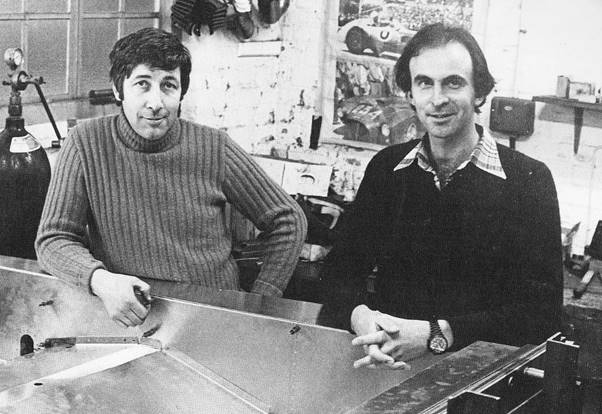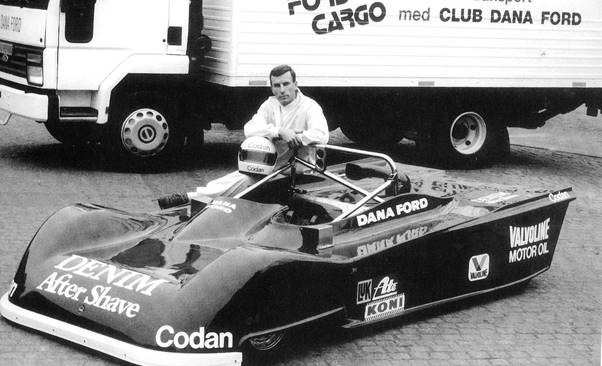Grand Prix Drivers Club president Howden Ganley has a regular column in the American historic magazine “Vintage Racecar Journal” and we acknowledge this in order to publish what Howden wrote in his most recent column about the origins – and the pronunciation – of the racing car he and fellow member Tim Schenken were involved with: the Tiga.

Forty years ago a small racing car manufacturer came into being. That was 1976, for those who prefer to have their arithmetic done for them. It was founded, almost by chance, by two ex-Formula One drivers, Tim Schenken and Howden Ganley (me). We were both coming to a point where we could see that one day our racing careers would need to come to an end, and so the “day jobs” would have to be replaced by something else.
Racing drivers, especially from Formula One, are by their nature somewhat unemployable, and therefore any future venture needed to be a form of self-employment, preferably associated with motor racing. As my wife liked to say to me from time to time, “You can’t play golf every day.”
So we agreed to start this business making racing cars, initially very low key so as to dovetail with our racing and testing commitments. Then came the tricky question of what to call the cars.
Tim initially suggested that they be called “Ganleys,” but I vetoed that. Car names can be quite the subject and we looked at many examples. Too many letters can render a name somewhat clumsy, or difficult to pronounce. The Italians have done rather well with it. Ferrari (seven letters), Maserati (eight letters), Bandini (seven letters) but messed up a bit with Stanguellini (twelve letters) although that was the founder’s name, so probably not a lot of options.
The Spaniards were doing well with Pegaso at six letters, and Hispano at seven, but then they spoiled that one by adding Suiza to it. The Germans were tidy at seven letters apiece for Porsche and Veritas, which kept it disciplined.

So back to naming our car. Having agreed that something like Deep Sanderson was overly long, not to say confusing, we laid down some criteria. A minimum of four letter, a maximum of five letters, preferably an animal (most were already taken) and if it could incorporate our own names that would be a bonus. My wife loved to do crosswords so she was given the job of producing a name that met our criteria. The result was Tiga. Four letters, an animal – sort of – and incorporating our names. Pronounced “tiger” ( Antipodean licence) it takes “Ti” from Tim and “Ga” from Ganley. Perfect, we thought but things are seldom that simple. It was not long before we were being assailed by people pronouncing it “Teega” and in the way of racing, the more we protested that the correct pronunciation was as the animal “Tiger” the more some of our opponents insisted that it was Teega.
Another faction wanted to call it “Tigger”.
Many are the arguments I have had. One chap informed me that ‘ I know the guy who owns that company and he told me it is Teega’ which gave me the obvious rebuttal, ‘Well I own that company and I am telling you it is Tyga’ End of discussion.
We were not alone. The Porsche family accentuate the “E” at the end of their name but very few other people do. Jaguar is frequently mangled into “Jagwah” or “Jagwire” and Nissan often becomes “Kneesarn”.
The Tyrrell team name also posted problems for some, with the most common version being “TieRell” Of course any name with two Rs and two Ls was bound to cause pronunciation problems for Japanese people yet Tyrrell was one of the most popular teams with Japanese enthusiasts.
In order to generate maximum publicity we did use our own names in the production company title, so the Tiga cars were built by “Tim Schenken-Howden Ganley Enginering Limited,” (almost as complicated as Deep Sanderson) and the nose badges reflected that, with Tiga in the centre and our names around the outside.
I got the message that this might not be as effective as hoped when I was helping a long-term customer to maximize his car performance. He suddenly said, “Tell me what exactly is your connection to the company, Tiga?” I led him to his car and pointed out my name on the badge. Apparently he had never spotted this before, which I guess is why there is nothing in the rulebook which says that it is compulsory for a racing car owner to have a high IQ.
When we started the company I said to Tim, “No matter how successful this becomes, I am not doing it for a day more than ten years”. My thinking being that we both had lots of other things to do in life apart from designing and building racing cars. Also I don’t think either of us had a totally clear vision of how it might all end up but in the event it went very well. We built just over 400 cars and probably at least that many again in spares for many different formulae from Formula Ford through Sports 2000, Formula Atlantic, Can-Am, Group C and IMSA. We also did engineering work for several Formula 1 teams. As the ten years rolled by we were both away to new adventures in racing, by now on the administration side. Did we make any mistakes? A few, for a start we should have taken the “Y” from Timothy and spelled it Tyga !!!
Howden’s column appears under the heading LAST LAP in Vintage Racecar Journal: Vintage Racecar Journal.com
